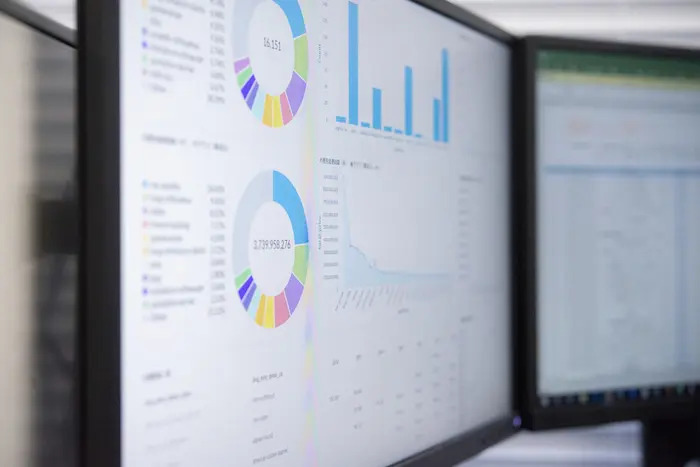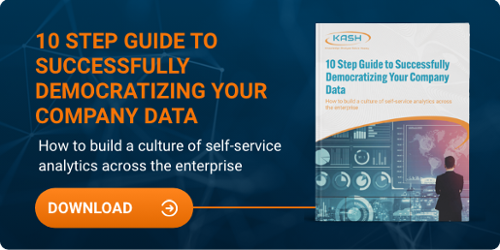What Is the Best Tool to Help Me Analyze My Data for My Business?
Topic:
Democratizing Data
As most business intelligence tools and platforms generally have similar features and functions, it’s important that you view your business holistically and ask yourself the right questions to determine your business needs before selecting the best Business Intelligence tools.
- What type of business are you in?
- What types of information consumers are you trying to reach?
- How much data are you managing?
- How many different types of data sources exist?
These are just some of the questions you need to think about when evaluating and selecting Business Intelligence solutions. A Business Intelligence tool or solution comparison should answer these questions and more. In this article, we’ll look at some of the keys to choosing the right Business Intelligence tools and solutions for your business.
Business Intelligence Tools vs. Platforms
One of the key decisions you’ll need to make is about how the data will be used. Business Intelligence tools are generally designed for a single user. In most cases, it is focused on your data analysts with deep IT experience. This provides them with the highly technical tools they need to do deep analysis.
By comparison, a Business Intelligence platform is typically developed with a broader enterprise-level audience across the organization in mind. A platform will accommodate many users, some of whom do not have the in-depth training your analysts would have.
A Business Intelligence platform generally will have a more friendly user interface, allowing use by a broad base of users. In addition, a UI-based product can often be customized to make it easier to use and personalized. Because it’s geared towards a broader audience, platforms also have different ways to visualize results with layers of presentation methods. Outputs are also more easily distributed. For example, published content can quickly be shared with others and dashboards can be developed.
One other advantage of a Business Intelligence platform is that you can also use it as a Business Intelligence tool. The right Business Intelligence platform for your business intelligence solutions can work for both data analysts and other stakeholders.
Who are the Users of the Business Intelligence Tool?
You must take into account who will be using the system. The user base will play a key role in determining the features you need. You want to choose a software tool that aligns with business needs.
It’s important to choose a system that will work well within your organizational structure to support and show relevant information to each type of user profile — from the C-suite to your supply chain. Each group has slightly different needs and differing degrees of technical expertise.
- Data Scientists need access to customize, build and model data into analytics. They will want to see all the data details.
- Business Analysts require more detailed information, but not to the level of a data scientist.
- Line-level managers need to only see what’s relevant to them in an intuitive and easy-to-understand way.
- Department-level employees also need to see what’s relevant to them that’s easy to access and understand.
- Company executives and managers want very accurate and repeatable high-level information about business performance.
Your business intelligence solutions will also have to provide the visibility and value organizations need to leverage their data for impactful insights.
The Importance of Workflows and Business Intelligence Solutions
Besides defining the users and their needs, you also need to think about how the end-user will use the Business Intelligence software.
The software needs to allow for an efficient workflow that is well-understood and repeatable. Otherwise, Business Intelligence tools often end up sitting on the shelf, no matter how sophisticated or beneficial they may be. Especially with self-service business intelligence tools that offer data democracy, users need an easy way to navigate the system to get results.
Start by looking at the users that will access the platform and evaluate how each user will interact with the software. What level of access do they need, how often do they need access, and what types of business insights do they need?
Usage in organizations can vary greatly. Some users may never need to touch the platform, instead using real-time data visualizations. Others may require more granular detail or the ability to drill down to deeper data dives.
How will the Business Intelligence Tool Integrate into the Existing Tech Stack?
When doing a Business Intelligence tools comparison, you also need to take into account your current tech stack. You want Business Intelligence tools that integrate within your existing systems and workflow for further use. Stand-alone Business Intelligence tools can be powerful, but they also tend to have lower user adoption rates.
If you’re building a data-centric workflow, you want Business Intelligence tools that integrate with what the tech people are already using to maximize adoption.
You also want to be able to customize your Business Intelligence tools to fit your specific use cases. For example, lightweight, low code, and no code development models allow users to create some fairly complex models without coding or deep expertise. At the same time, data scientists should have access to Python or R scripts, for example, to develop more complex data workflows to train and run analytical models.
The Adoption of Business Intelligence Tools Hinge on Training, Support & Shared Knowledge
A common complaint from users about Business Intelligence tools and Business Intelligence platforms is that there is a lack of training and support. To leverage data insights, users need to know the best way to use the platform and extract the data.
Any Business Intelligence solution you choose should offer extensive training, geared for different levels of users. Depending on your organization, you may want live training, online instruction, or DYI training resources.
Another important aspect is the shared knowledge that is available. Some of the best Business Intelligence platforms have dedicated user bases, which share their knowledge and help others within the user base. One big concern is closed audience user forums, where information is not easily accessible or shared. You want to work with Business Intelligence tools that have an open and active community online.
You’ll also want to examine the level of support provided by your Business Intelligence vendor. For example, do they offer premium support, such as a vendor ticket system that moves you to the front of the line? When analytics are mission-critical, you can’t afford downtime caused by poor access to support.
How will the Business Intelligence Tool Integrate with IT Infrastructure?
Even if it’s cloud-based software, there will still be some kind of integration required of your IT team unless you purchase a one-off tool that sits on one machine.
You’ll want to clearly define responsibilities. For example, when you start building dashboards, who will maintain them over time? If you’ve integrated with your IT infrastructure, there will be certain applications that may be developed at the department or user level, but may need to pass over to the IT team for longer-term maintenance and support going forward. Having a clear understanding will help resolve conflicts later on.
Most companies charge IT teams, with control of the data that feeds the system, but there is typically shared ownership of the tools and outcomes. It may be different within your organization, but the decisions you make can help determine the structure you need.
Business Intelligence Tools Comparison
When comparing Business Intelligence tools, you should always work backward, starting with the people that will use the tools and what they need moving back to the actual data. You also need to define your workflow and reporting. By asking what these users need to effectively do their job, you can make better decisions about the Business Intelligence tool or Business Intelligence platform you ultimately choose.
By asking the right questions and getting the answers, you can uncover the data you need to determine which tool or platform best fits your unique business needs.
Discover how you can get the most value from your technology investments by downloading the eBook, "10 Step Guide to Successfully Democratizing Your Company Data."

